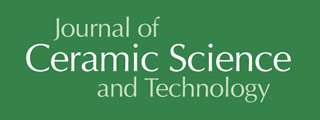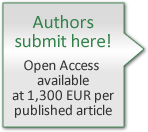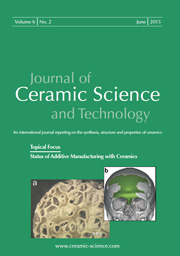Articles
All articles | Recent articles
Crack Formation and Shape of Fracture Surface in Tabular-Alumina-Based Castables with Addition of Specific Aggregates
J. Schnieder, L. Lynen, N. Traon, T. Tonnesen, R. Telle
RWTH Aachen University, Institute of Mineral Engineering, Templergraben 55, 52062 Aachen, Germany
received November 08, 2013, received in revised form January 17, 2014, accepted March 13, 2014
Vol. 5, No. 2, Pages 131-136 DOI: 10.4416/JCST2013-00039
Abstract
Understanding the mechanical fracture and the microstructural behavior of refractories subject to thermal shock treatment is fundamental for the design of high-performance refractory materials. In recent decades, understanding has been focused on mechanisms occurring at the crack tip, namely in advanced ceramics. The focus recently switched to phenomena occurring in a different process zone of the crack, the wake region or following process zone. To understand the mechanisms in this wake region, specific aggregates are used in a model castable formulation based on tabular alumina, namely eutectic aggregates composed of Al2O3-ZrO2-SiO2 and Al2O3-ZrO2. The influence of these aggregates on the elastic and thermo-mechanical properties as well as on the crack path and the fracture surface is examined. This survey will put emphasis on the impact of each aggregate on the fracture surface and the crack path after the model castable has undergone several thermal shock cycles.
![]() Download Full Article (PDF)
Download Full Article (PDF)
Keywords
Refractories, microstructure analysis, eutectic aggregates, thermal shock
References
1 Refractories handbook, edited by Charles A. Schacht, Chapter 2, Bradt, R.C., Fracture of Refractories, 11 – 38, ISBN: 0 – 8247 – 5654 – 1
2 Steinbrech, R.W., Reichl, A., Schaarwächter, W.: R-curve behavior of long cracks in alumina, J. Am. Ceram. Soc., 73, [7], 2009 – 2015, (1990).
3 Steinbrech, R.W., Schmenkel, O.: Crack resistance curves of surface cracks in alumina, J. Am. Ceram. Soc., 71, [5], (1988).
4 Skiera, E., Malzbender, J., Mönch, J. Dudczig, S., Aneziris, C.G., Steinbrech, R.W.: Controlled crack propagation experiments with a novel alumina-based refractory, Adv. Eng. Mater., 14, [4], 248 – 254, (2012).
5 Bradt, R.C.: Crack extension in refractories. Proc. Unitecr '11; Kyoto 30.10.-02.11.(2011), Paper No. 2-D-5
6 Harmuth, H., Bradt, R.C.: Investigation of refractory brittleness by fracture mechanical and fractographic methods, Manual, 6 – 10, (2010).
7 Miyaji, D.J., Tonnesen, T., Rodrigues, J.D.A.: Eutectic aggregates containing refractory castables: What are their effects on fracture energy and thermal shock damage resistance? Proc. Unitecr '11, Kyoto, 30.10.-02.11.2011, Paper No. 2-D-3.
8 Miyaji, D.J., Otofuji, C., Rodrigues, J.D.A.: The load-displacement curve of steady crack propagation: An interesting source of information for predicting the thermal shock damage of refractories Proc. Unitecr '13, Victoria, Paper No. 17 – 10.
9 Pandolfelli, V.C., Salvini, V.R., Brant, P.O.R.C., Noronha, R.T.T., Mattos, U.: Influence of mullite-zirconia aggregate addition on the thermomechanical properties of high-alumina refractories, Unitecr '93 Congress, Sao Paulo, Brazil, 1993.
10 Pandolfelli, V.C., Salvini, V.R., Rodrigues, J.A., Hübner, H., Wolf, C.: Evaluation of thermomechanical properties of alumina refractories containing a fused mullite-zirconia aggregate, Unitecr '95, Kyoto, Japan, 2, 1995.
11 Tessier-Doyen, N., Glandus, J.C., Huger, M.: Anisotropic untypical Young's modulus evolution of model refractories at high temperature, J. Eur. Ceram. Soc., 26, 289 – 295, (2006).
12 Kakroudi, M.G., Huger, M., Gault, C., Chotard, T.: Anisotropic behaviour of andalusite particles used as aggregates on refractory castables, J. Eur. Ceram. Soc., 29, 571 – 579, (2009).
13 Schnieder, J., Lynen, L., Traon, N., Tonnesen, T., Telle, R.: Influence of eutectic aggregates in castables on the thermal shock resistance, International Colloquium on Refractories 2013, Aachen.
14 Hasselmann, D.P.H.: Unified theory of thermal shock fracture initiation and crack propagation in brittle ceramics, J. Am. Ceram. Soc., 52, [11], 600 – 604, (1969).
15 Salvini, V.R., Pandolfelli, V.C., Bradt, R.C.: Extension of hasselman's thermal shock theory for crack/microstructure interaction in refractories. Ceram. Int., 38, 5369 – 5375, (2012).
Copyright
Göller Verlag GmbH


